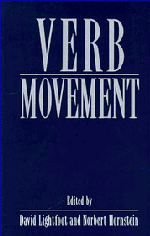Book contents
- Frontmatter
- Contents
- List of contributors
- Preface
- Verb movement: an introduction
- 1 Verb positions: evidence from Italian
- 2 Verb movement and word order in Arabic
- 3 Comments on the paper by Ouhalla
- 4 Some similarities and differences between Icelandic and Yiddish
- 5 Comments on the paper by Santorini
- 6 Finite verb movement in Scandinavian embedded clauses
- 7 Comments on the paper by Vikner
- 8 The Brythonic copula and head raising
- 9 A reinterpretation of evidence for verb movement in French
- 10 Two types of head movement in Romance
- 11 Comments on the paper by Roberts
- 12 Licensing heads
- 13 Comments on the paper by Koopman
- 14 Finiteness and head movement in early child grammars
- 15 Comments on the paper by Wexler
- References
- Index
12 - Licensing heads
Published online by Cambridge University Press: 03 May 2011
- Frontmatter
- Contents
- List of contributors
- Preface
- Verb movement: an introduction
- 1 Verb positions: evidence from Italian
- 2 Verb movement and word order in Arabic
- 3 Comments on the paper by Ouhalla
- 4 Some similarities and differences between Icelandic and Yiddish
- 5 Comments on the paper by Santorini
- 6 Finite verb movement in Scandinavian embedded clauses
- 7 Comments on the paper by Vikner
- 8 The Brythonic copula and head raising
- 9 A reinterpretation of evidence for verb movement in French
- 10 Two types of head movement in Romance
- 11 Comments on the paper by Roberts
- 12 Licensing heads
- 13 Comments on the paper by Koopman
- 14 Finiteness and head movement in early child grammars
- 15 Comments on the paper by Wexler
- References
- Index
Summary
Introduction
The principles governing the structure of syntactic representations can be seen as a collection of licensing conditions that categories of various types have to meet. Arguments, for example, need to be licensed by theta-role assignment, overt NPs by Case, small pro by being identified, negative polarity items by negative elements, anaphors by being appropriately bound to antecedents, expletive pronouns by being replaced by an NP at LF. Licensing conditions are stated in terms of a number of primitive features (nominal or verbal, phonetic or covert, etc.) and relations (government, c-command, Spec-head agreement, coindexing, etc.).
In recent work, Sportiche (1992) has suggested that an entire set of licensing conditions could be reduced to one, namely Spec-head licensing. As illustration, consider two major cases of syntactic XP-movement: wh-movement and NP movement. They represent movement to Spec positions (Spec of CP and Spec of AGRsP, Spec of AGRoP). This type of movement represents a way to license particular XPs, either because the XP is a wh-phrase and has to be licensed in Spec of CP, or because the XP needs Case. Spec positions thus typically function as “licensing” positions, and (overt or covert) movement represents the means to fulfill the licensing requirement: a particular XP is licit because it “counts” as being in the Spec position of a particular (licensing) head.
This general idea brings together a number of results from recent work that has established the privileged status of Spec positions as licensing positions.
- Type
- Chapter
- Information
- Verb Movement , pp. 261 - 296Publisher: Cambridge University PressPrint publication year: 1994
- 9
- Cited by



